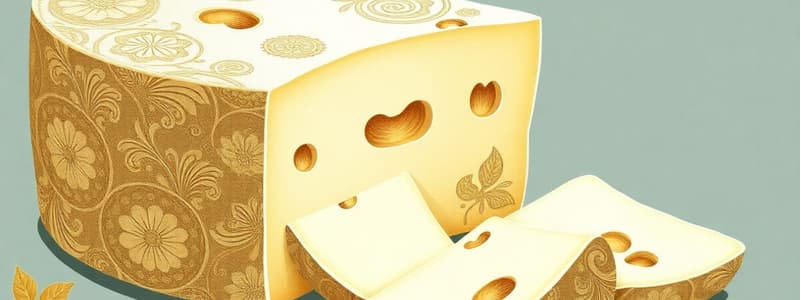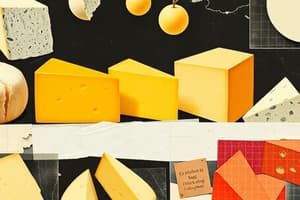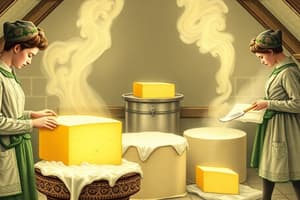Podcast
Questions and Answers
Which characteristic is the primary basis for classifying cheeses?
Which characteristic is the primary basis for classifying cheeses?
- Salt content
- Fat content
- Moisture content (correct)
- Protein content
According to moisture content, how would a cheese with 60% moisture be classified?
According to moisture content, how would a cheese with 60% moisture be classified?
- Soft Cheese (correct)
- Fresh Cheese
- Hard Cheese
- Semihard Cheese
Which of the following cheeses has the lowest moisture content?
Which of the following cheeses has the lowest moisture content?
- Parmesan (correct)
- Brie
- Cottage Cheese
- Gouda
If a cheese is defined as having '>80% moisture', which type of cheese is it?
If a cheese is defined as having '>80% moisture', which type of cheese is it?
Which of the following cheese types is defined as having between 40-50% moisture?
Which of the following cheese types is defined as having between 40-50% moisture?
A cheese maker is developing a new cheese and aims for a semi-hard consistency. What approximate moisture range should they target?
A cheese maker is developing a new cheese and aims for a semi-hard consistency. What approximate moisture range should they target?
Why is moisture content an important factor in cheese classification?
Why is moisture content an important factor in cheese classification?
Which coagulation method defines all cheeses according to the FDA?
Which coagulation method defines all cheeses according to the FDA?
Which option provides the correct examples for the following cheese classifications respectively: Soft, Hard, Fresh.
Which option provides the correct examples for the following cheese classifications respectively: Soft, Hard, Fresh.
In the context of cheese production, what is curd?
In the context of cheese production, what is curd?
A cheese maker discovers that a batch of cheese has a moisture content of 82%. What adjustments can be made to reduce the moisture to classify the batch as soft cheese?
A cheese maker discovers that a batch of cheese has a moisture content of 82%. What adjustments can be made to reduce the moisture to classify the batch as soft cheese?
How does the moisture content of cheese affect its shelf life?
How does the moisture content of cheese affect its shelf life?
What legal significance does the FDA's definition of cheese have for manufacturers?
What legal significance does the FDA's definition of cheese have for manufacturers?
Which of the following is NOT a true statement about cheese classification?
Which of the following is NOT a true statement about cheese classification?
If a cheese has a very low moisture content, what characteristics would be expected?
If a cheese has a very low moisture content, what characteristics would be expected?
Why might a cheese maker choose to produce a cheese with high moisture content, despite its shorter shelf life?
Why might a cheese maker choose to produce a cheese with high moisture content, despite its shorter shelf life?
Which of the following is NOT a purpose of the FDA’s classification of cheese by moisture content?
Which of the following is NOT a purpose of the FDA’s classification of cheese by moisture content?
If a cheese is labeled as “artisanal” and has a moisture content of 78%, how would you classify it based only on the information provided?
If a cheese is labeled as “artisanal” and has a moisture content of 78%, how would you classify it based only on the information provided?
What issues might arise if a cheese producer mislabels a ‘semi-hard’ cheese (45% moisture) as ‘fresh’ (82% moisture)?
What issues might arise if a cheese producer mislabels a ‘semi-hard’ cheese (45% moisture) as ‘fresh’ (82% moisture)?
When comparing two cheeses -- one classified as 'hard' (35% moisture) and another as 'soft' (65% moisture) -- what differences could one expect to find in their production processes?
When comparing two cheeses -- one classified as 'hard' (35% moisture) and another as 'soft' (65% moisture) -- what differences could one expect to find in their production processes?
Flashcards
What is cheese?
What is cheese?
A preserved food made from milk curd, consisting mainly of water, fat, and protein.
What are fresh cheeses?
What are fresh cheeses?
Cheeses with more than 80% moisture content.
What are soft cheeses?
What are soft cheeses?
Cheeses with 50-75% moisture content.
What are semihard cheeses?
What are semihard cheeses?
Signup and view all the flashcards
What are hard cheeses?
What are hard cheeses?
Signup and view all the flashcards
Study Notes
- Cheese is a preserved food from milk curd, mainly water, fat, and protein
- According to the FDA, cheese is made from curd obtained from milk, with or without added cream, coagulated by enzymes or acids
Moisture Content
- Fresh Cheeses: Moisture content is greater than 80% (e.g., cottage cheese, cream cheese)
- Soft Cheeses: Moisture content is 50-75% (e.g., Brie, Camembert)
- Semihard Cheeses: Moisture content is 40-50% (e.g., Gouda, Muenster)
- Hard Cheeses: Moisture content is 30-40% (e.g., Cheddar, Swiss)
Studying That Suits You
Use AI to generate personalized quizzes and flashcards to suit your learning preferences.




